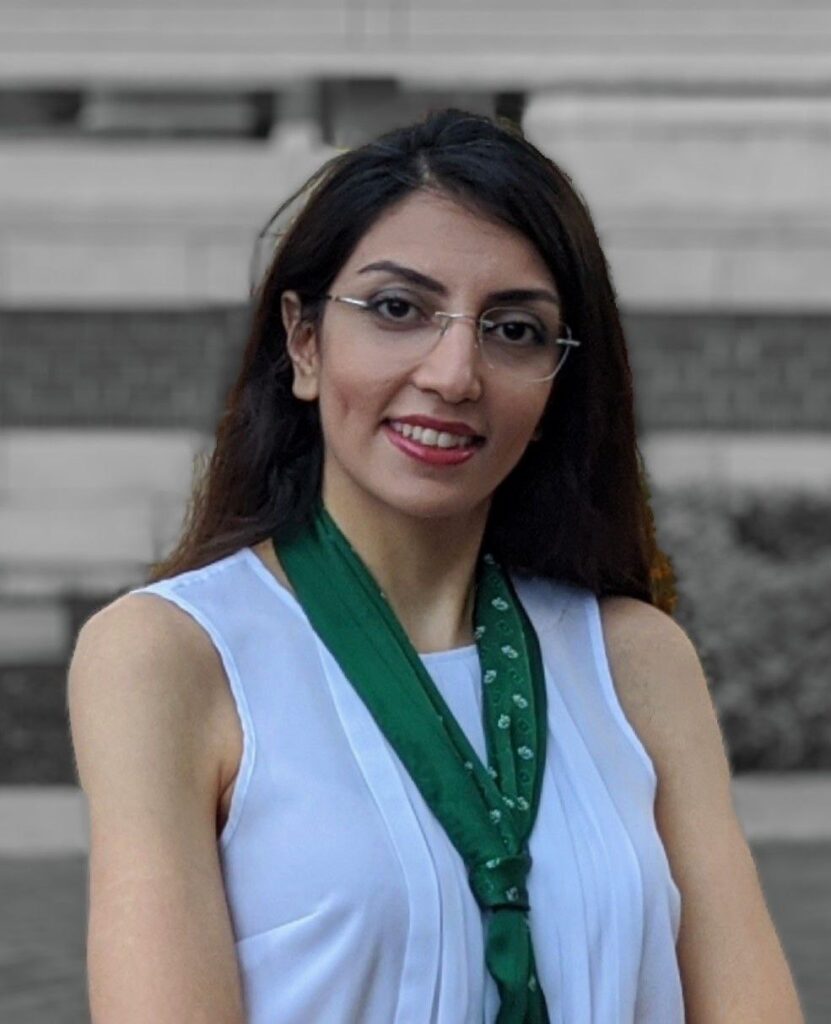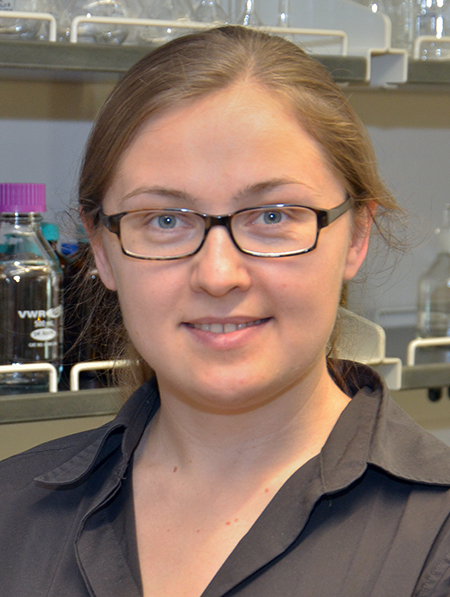Treating Algal Toxins in Drinking Water with Dr. Olya Keen

By Justin Lindemann
Olya Keen, Ph.D., a civil and environmental engineer at the University of North Carolina Charlotte’s (UNCC) William States Lee College of Engineering, studies emerging contaminants and wastewater treatment, through ultraviolet (UV) based technology, advanced oxidation, and biological treatment. She was a WRRI-supported researcher in 2019 for her work on treating algal toxins in drinking water through UV applications.
The project focuses on the comparative usage of UV/Cl2 (UV and chlorine) and UV/H2O2 (UV and hydrogen peroxide) advanced oxidation to treat algal toxins in sources of drinking water that could be susceptible to harmful algal blooms, which are quite common in warm freshwater environments with lots of phosphorus and nitrogen nutrients and can have negative impacts on human health. Advanced oxidation is a chemical treatment process designed to decompose organic material in water, in particular chemicals that may be harmful even at low concentrations. Additionally, UV alone without the addition of Cl2 or H2O2 is a common disinfection method for drinking water and wastewater before it is returned back into the waterways
At a drinking water treatment plant, water is typically chlorinated after advanced oxidation, to prevent any microbial growth in the water distribution pipes that move the water to and from its source, Keen explains. But she adds that “this chlorination process generates disinfection byproducts that are carcinogenic and need to be mitigated.” Basically, the common practice of using chlorine as a disinfectant, can bring about unhealthy consequences; for those that might later consume/use the water — and thus needs to be reduced.
That is why she and Fateme Barancheshme, a key researcher on this project and recent Ph.D. graduate from the UNCC civil engineering program, are looking at the effectiveness of UV/Cl2 and UV/H2O2 as a chemical treatment for the most prevalent algal toxins, and that both treatments do not inadvertently increase the carcinogenic byproducts to concerning levels.
Keen summarizes the research: “Our investigation examined whether advanced oxidation increases formation of disinfection byproducts, especially when algal organic matter is present, and whether toxins lose their toxicity in the treatment process.”
Why UV/Cl2 and UV/H2O2?
There are multiple reasons as to why UV/Cl2 and UV/H2O2 were chosen as treatment methods. Keen explains, “UV/H2O2 is the most commercially available and understood method. While, UV/Cl2 is still relatively novel and requires further study, especially since chlorine is involved, resulting in a higher chance that some undesirable substances may form.” She adds that UV/Cl2 could offer various advantages over UV/H2O2, and if found to have comparable effects, could be “a very promising commercially advanced oxidation process”.

The process of UV/Cl2 and UV/H2O2 advanced oxidation works through the absorption of UV energy by Cl2 or H2O2, bringing about the development of highly reactive chemicals called hydroxyl radicals.
“These radicals are highly reactive and non-selective, meaning they react with almost any molecule they encounter, and at a very fast rate. Most of the organic contaminants are good candidates for oxidation by hydroxyl radicals. Given enough time, these radicals can completely decompose an organic molecule.”
This process is called mineralization as the molecule breaks down into inorganic, or mineral, components. However, Keen says that “it will take too much energy to completely mineralize contaminants during water treatment, and that is why studying the intermediate products that form during partial breakdown of those chemicals and their properties is so important.”
Student No More

Barancheshme wrote her dissertation on the treatment of algal toxins in drinking water with UV-based advanced oxidation processes. “I’ve always had a passion for improving public health and resolving problems of critical importance. Having access to clean drinking water is vital for human health, peace, and security. I am thankful for having the opportunity to work on this project that was totally in line with my passion and my research goals,” she described her motivations.
Now a scientist working in a dynamic field, Barancheshme explains how she will use her knowledge and experience: “I am applying the skill set I’ve acquired through my Ph.D. project, like developing novel methods, applying new techniques, creative and critical thinking, and troubleshooting skills. During my post-doc and now as R&D scientist, I’ve used my UV-related background for projects on combating COVID-19 by disinfecting personal protective equipment (PPE) and environmental surfaces.”
Free Radicals and Real-World Consequences
The collaboration between Keen and Barancheshme has real-world applications that can upend multiple issues. Keen talks about the harm that free radicals — unstable atoms that can damage cells and cause illness —can impose on our body and how they can be used for good in water treatment.
“They are harmful because they react with the organic molecules that are the building blocks of our bodies. In water treatment, we can purposefully generate free radicals and direct their wrath onto organic pollutants. They don’t care what to oxidize! One of the organic pollutants that they can help destroy in drinking water is algal toxins. These toxins are generated by specific organisms that thrive in warm polluted waters.”
She connects the growth of algal toxins and its potential damage to the climate crisis, describing how the world’s waters are getting warmer and more polluted, offering a thriving home for the contaminant.
Keen also elaborates on the structural injury that these toxins can impose on our water supply, what that would mean for a municipality, and how her research in particular is meant to help.
“When toxic algae grows in our water supplies, the water needs to undergo treatment processes to prevent toxins from reaching the water taps in our homes. If these toxins are found in our drinking water and the necessary treatment is not available at the water plant, the water supply needs to be shut down until the toxin level decreases naturally. That is a very difficult and expensive approach, and it has happened before in major cities, such as, Toledo, Ohio, in 2014. Our research examined the effectiveness of treatment processes that create free radicals to destroy these toxins at the drinking water treatment plants before they can reach our homes.”
As for the health effects from ingesting algae toxins through a contaminated water supply, they are varied.
“The most prevalent are microcystins, which are liver toxins. At high enough levels they cause gastrointestinal symptoms and even liver failure. Other toxins are neurotoxins and cause seizures by attacking our nervous system.”
Treatment for Better Water Quality
Keen hopes that her research will help find economically viable solutions for addressing organic contaminants, including algal toxins, in drinking water.
“Advanced oxidation is a very promising technology for treating organic contaminants. If we can demonstrate that the toxins lose their toxicity with minimal treatment, then maybe advanced oxidation could be adopted as a standard for surface water susceptible to algal blooms.”
In addition to her research project on the use of UV/Cl2 and UV/H2O2, Keen is working on a variety of issues related to contaminants of emerging concern.

“One of my projects that is about to conclude focused on treatment of pharmaceuticals and plasticizers, in landfill leachate. However, we used biological treatment, not advanced oxidation. Advanced oxidation works better in cleaner, less-complex water types A new project that recently started is aimed at determining the fate of microplastics in wastewater treatment processes. Apart from this, I am continuing to work with advanced oxidation to make it a more user-friendly treatment process.”
Overall, with her research focused on mitigation of rising contaminants. Keen believes prevention is often the better approach.
“Many of the choices we make in everyday life can make a difference in preventing pollution.”
With the climate getting warmer, giving way to increased algal blooms and water quality issues, as well as the emergence of microplastics and other pollutants in our drinking water, Keen’s research is there to find effective treatments that apply to these varying pollutants, that then create a safer environment.
Find out more about Keen’s research here: https://coefs.uncc.edu/okeen/
Opening image by Yasin Arıbuğa on Unsplash
- Categories:



